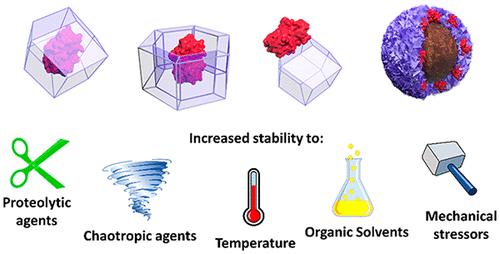当前位置:
X-MOL 学术
›
Chem. Rev.
›
论文详情
Our official English website, www.x-mol.net, welcomes your
feedback! (Note: you will need to create a separate account there.)
Metal–Organic Framework-Based Enzyme Biocomposites
Chemical Reviews ( IF 51.4 ) Pub Date : 2021-01-13 , DOI: 10.1021/acs.chemrev.0c01029 Weibin Liang 1 , Peter Wied 2 , Francesco Carraro 2 , Christopher J Sumby 1 , Bernd Nidetzky 3 , Chia-Kuang Tsung 4 , Paolo Falcaro 2 , Christian J Doonan 1
Chemical Reviews ( IF 51.4 ) Pub Date : 2021-01-13 , DOI: 10.1021/acs.chemrev.0c01029 Weibin Liang 1 , Peter Wied 2 , Francesco Carraro 2 , Christopher J Sumby 1 , Bernd Nidetzky 3 , Chia-Kuang Tsung 4 , Paolo Falcaro 2 , Christian J Doonan 1
Affiliation

|
Because of their efficiency, selectivity, and environmental sustainability, there are significant opportunities for enzymes in chemical synthesis and biotechnology. However, as the three-dimensional active structure of enzymes is predominantly maintained by weaker noncovalent interactions, thermal, pH, and chemical stressors can modify or eliminate activity. Metal–organic frameworks (MOFs), which are extended porous network materials assembled by a bottom-up building block approach from metal-based nodes and organic linkers, can be used to afford protection to enzymes. The self-assembled structures of MOFs can be used to encase an enzyme in a process called encapsulation when the MOF is synthesized in the presence of the biomolecule. Alternatively, enzymes can be infiltrated into mesoporous MOF structures or surface bound via covalent or noncovalent processes. Integration of MOF materials and enzymes in this way affords protection and allows the enzyme to maintain activity in challenge conditions (e.g., denaturing agents, elevated temperature, non-native pH, and organic solvents). In addition to forming simple enzyme/MOF biocomposites, other materials can be introduced to the composites to improve recovery or facilitate advanced applications in sensing and fuel cell technology. This review canvasses enzyme protection via encapsulation, pore infiltration, and surface adsorption and summarizes strategies to form multicomponent composites. Also, given that enzyme/MOF biocomposites straddle materials chemistry and enzymology, this review provides an assessment of the characterization methodologies used for MOF-immobilized enzymes and identifies some key parameters to facilitate development of the field.
中文翻译:

基于金属-有机框架的酶生物复合材料
由于它们的效率、选择性和环境可持续性,酶在化学合成和生物技术中具有重要的机会。然而,由于酶的三维活性结构主要由较弱的非共价相互作用维持,因此热、pH 和化学压力因素可以改变或消除活性。金属有机框架 (MOF) 是一种扩展的多孔网络材料,通过自下而上的构建块方法从基于金属的节点和有机连接器组装而成,可用于为酶提供保护。当 MOF 在生物分子存在下合成时,MOF 的自组装结构可用于在称为封装的过程中包裹酶。或者,酶可以通过共价或非共价过程渗透到介孔 MOF 结构或表面。以这种方式整合 MOF 材料和酶可提供保护并允许酶在挑战条件下(例如,变性剂、升高的温度、非天然 pH 值和有机溶剂)保持活性。除了形成简单的酶/MOF 生物复合材料外,还可以将其他材料引入复合材料中,以提高回收率或促进传感和燃料电池技术的高级应用。这篇综述探讨了通过封装、孔渗透和表面吸附对酶的保护,并总结了形成多组分复合材料的策略。此外,鉴于酶/MOF 生物复合材料跨越材料化学和酶学,
更新日期:2021-02-10
中文翻译:

基于金属-有机框架的酶生物复合材料
由于它们的效率、选择性和环境可持续性,酶在化学合成和生物技术中具有重要的机会。然而,由于酶的三维活性结构主要由较弱的非共价相互作用维持,因此热、pH 和化学压力因素可以改变或消除活性。金属有机框架 (MOF) 是一种扩展的多孔网络材料,通过自下而上的构建块方法从基于金属的节点和有机连接器组装而成,可用于为酶提供保护。当 MOF 在生物分子存在下合成时,MOF 的自组装结构可用于在称为封装的过程中包裹酶。或者,酶可以通过共价或非共价过程渗透到介孔 MOF 结构或表面。以这种方式整合 MOF 材料和酶可提供保护并允许酶在挑战条件下(例如,变性剂、升高的温度、非天然 pH 值和有机溶剂)保持活性。除了形成简单的酶/MOF 生物复合材料外,还可以将其他材料引入复合材料中,以提高回收率或促进传感和燃料电池技术的高级应用。这篇综述探讨了通过封装、孔渗透和表面吸附对酶的保护,并总结了形成多组分复合材料的策略。此外,鉴于酶/MOF 生物复合材料跨越材料化学和酶学,











































 京公网安备 11010802027423号
京公网安备 11010802027423号